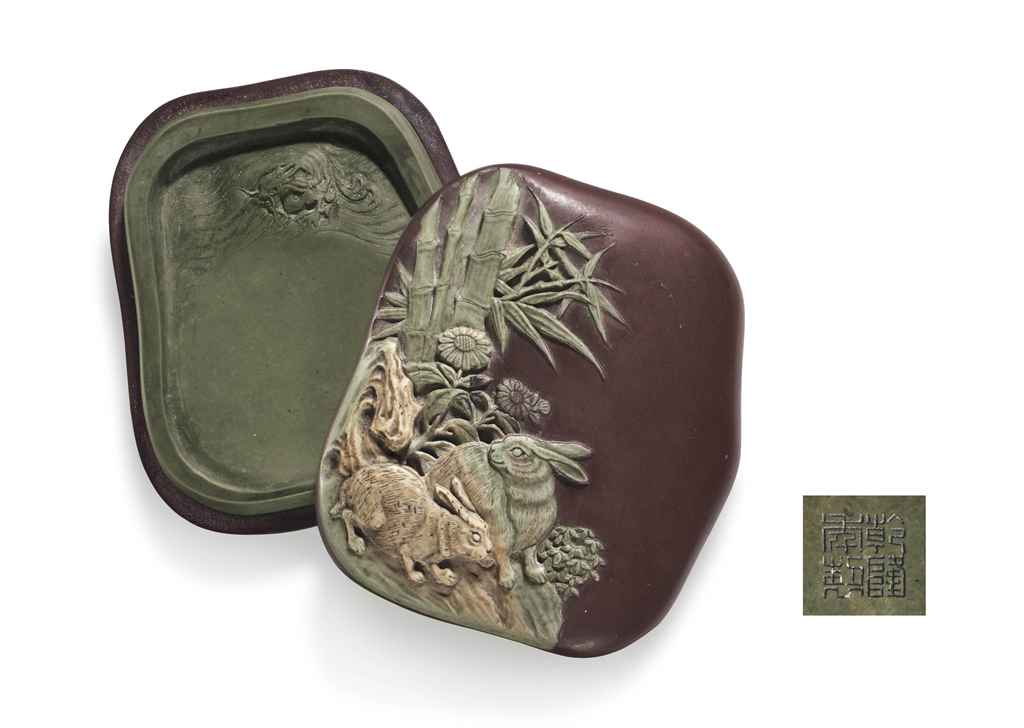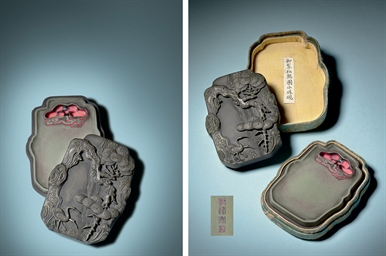Lot details China, 1736-1795. The soft grayish-green ink stone is of magnificent quality with distinct striations and deeply carved with a lingzhi-shaped well. The outline conforms with the highest possible precision to that of the shallow box and cover, which in turn is finely carved on the top through the grayish-green outer layer to the purplish-brown under layer with two crested cranes perched on the trunk of a gnarled pine tree, the burls in the wood superbly sculpted, the pine leaves and the cranes’ plumages neatly incised. The base of the inkstone incised in a line with a four-character seal mark Qianlong nianzhi and of the period. Provenance: Mrs. Walter Sedgwick, collection no. 307, as per old label to base, and thence by descent. Probably Sotheby’s London after 1968 and from there into a French collection. Parisian trade, acquired from the above. Mrs. Walter Sedgwick (1883-1967) was an English collector of Chinese art who came from a family of architects. Quite unusually at the time, she collected independently of her husband who was a barrister with little interest in Chinese art. She lent many pieces to the 1935-36 Chinese exhibition at the Royal Academy. Soame Jenyns described her as a collector of impeccable taste and in 1953 dedicated his book 'Ming Pottery and Porcelain' to her. She donated and bequeathed Chinese objects to the British Museum from 1933 to 1968 and was a generous benefactor to the British Museum, the Fitzwilliam in Cambridge, and the Victoria & Albert Museum. After her death, her collection was sold off by Sotheby’s London beginning in 1968. Mrs. Sedgwick was the aunt of Professor Jessica Rawson. Condition: Excellent condition with only minor wear and traces of use. Weight: 243.6 g Dimensions: Length 9 cm Expert’s note: The present lot was no doubt made during the Qianlong period, a fact illuminated by a Songhua ink stone, box, and cover dated to the Republic period at Christie’s Hong Kong, 9 October 2019, lot 270. Although this later example appears quite similar to the present lot at first glance, it quickly becomes evident that it does not even remotely show the same exceptional skill and attention to detail. Closer study reveals a vast number of small yet striking differences, including the two cranes, which lack the crests and open beaks, as well as the pine leaves, which lack the raised edges of their central circles, and last but not least the Imperial mark itself, which is by far not as neatly incised. Songhua stone, for its color, quality and ease of grinding the ink, was one of the preferred materials for making inkstones for the scholar's table during the Qing dynasty. Chi Jo-hsin in 'A study of the Sunghua Inkstone Tradition', Special Exhibition of Sunghua Inkstone, National Palace Museum, Taipei, 1993, page 38, notes that 'during the Qianlong period, an inventory of inkstones in the Imperial Household was compiled. Of the more than two hundred entries, six sunghua inkstones with imperial reign marks of the K'ang-hsi, Yung-cheng and Ch'ien-lung periods are recorded, five of which are in the collection of the National Palace Museum.' Design on inkstones often imitated fine paintings and it is known that the Qianlong emperor commissioned his court painters to design the lids of many of his inkstones. Shapes of the ink pool and cover also became more varied during the Qianlong emperor's reign, when new shapes in the form of peaches, crescent-moons and flowers were introduced alongside the traditional circular, octagonal and oblong shapes. In Qianlong’s poetry collection ‘Shengjing tuchan zoayang shier shou’ (Twelve Miscellaneous Poems on the Native Products of Shengjing), the emperor praises the stone as 'Songhua yu' (Songhua jade) and mentions that it is the product of the Yuantong River in Jilin province in northeast China and can be used for making inkstones. Zhou Nanquan notes in 'Songhuashi yan' (Songhua Inkstone), Wenwu, 1980, no. 1, pages 86-87, that Songhua stone was used for th
Lot details China, 1736-1795. The soft grayish-green ink stone is of magnificent quality with distinct striations and deeply carved with a lingzhi-shaped well. The outline conforms with the highest possible precision to that of the shallow box and cover, which in turn is finely carved on the top through the grayish-green outer layer to the purplish-brown under layer with two crested cranes perched on the trunk of a gnarled pine tree, the burls in the wood superbly sculpted, the pine leaves and the cranes’ plumages neatly incised. The base of the inkstone incised in a line with a four-character seal mark Qianlong nianzhi and of the period. Provenance: Mrs. Walter Sedgwick, collection no. 307, as per old label to base, and thence by descent. Probably Sotheby’s London after 1968 and from there into a French collection. Parisian trade, acquired from the above. Mrs. Walter Sedgwick (1883-1967) was an English collector of Chinese art who came from a family of architects. Quite unusually at the time, she collected independently of her husband who was a barrister with little interest in Chinese art. She lent many pieces to the 1935-36 Chinese exhibition at the Royal Academy. Soame Jenyns described her as a collector of impeccable taste and in 1953 dedicated his book 'Ming Pottery and Porcelain' to her. She donated and bequeathed Chinese objects to the British Museum from 1933 to 1968 and was a generous benefactor to the British Museum, the Fitzwilliam in Cambridge, and the Victoria & Albert Museum. After her death, her collection was sold off by Sotheby’s London beginning in 1968. Mrs. Sedgwick was the aunt of Professor Jessica Rawson. Condition: Excellent condition with only minor wear and traces of use. Weight: 243.6 g Dimensions: Length 9 cm Expert’s note: The present lot was no doubt made during the Qianlong period, a fact illuminated by a Songhua ink stone, box, and cover dated to the Republic period at Christie’s Hong Kong, 9 October 2019, lot 270. Although this later example appears quite similar to the present lot at first glance, it quickly becomes evident that it does not even remotely show the same exceptional skill and attention to detail. Closer study reveals a vast number of small yet striking differences, including the two cranes, which lack the crests and open beaks, as well as the pine leaves, which lack the raised edges of their central circles, and last but not least the Imperial mark itself, which is by far not as neatly incised. Songhua stone, for its color, quality and ease of grinding the ink, was one of the preferred materials for making inkstones for the scholar's table during the Qing dynasty. Chi Jo-hsin in 'A study of the Sunghua Inkstone Tradition', Special Exhibition of Sunghua Inkstone, National Palace Museum, Taipei, 1993, page 38, notes that 'during the Qianlong period, an inventory of inkstones in the Imperial Household was compiled. Of the more than two hundred entries, six sunghua inkstones with imperial reign marks of the K'ang-hsi, Yung-cheng and Ch'ien-lung periods are recorded, five of which are in the collection of the National Palace Museum.' Design on inkstones often imitated fine paintings and it is known that the Qianlong emperor commissioned his court painters to design the lids of many of his inkstones. Shapes of the ink pool and cover also became more varied during the Qianlong emperor's reign, when new shapes in the form of peaches, crescent-moons and flowers were introduced alongside the traditional circular, octagonal and oblong shapes. In Qianlong’s poetry collection ‘Shengjing tuchan zoayang shier shou’ (Twelve Miscellaneous Poems on the Native Products of Shengjing), the emperor praises the stone as 'Songhua yu' (Songhua jade) and mentions that it is the product of the Yuantong River in Jilin province in northeast China and can be used for making inkstones. Zhou Nanquan notes in 'Songhuashi yan' (Songhua Inkstone), Wenwu, 1980, no. 1, pages 86-87, that Songhua stone was used for th
.jpg)
.jpg)
.jpg?w=400)
.jpg)





.jpg)

.jpg)


Testen Sie LotSearch und seine Premium-Features 7 Tage - ohne Kosten!
Lassen Sie sich automatisch über neue Objekte in kommenden Auktionen benachrichtigen.
Suchauftrag anlegen